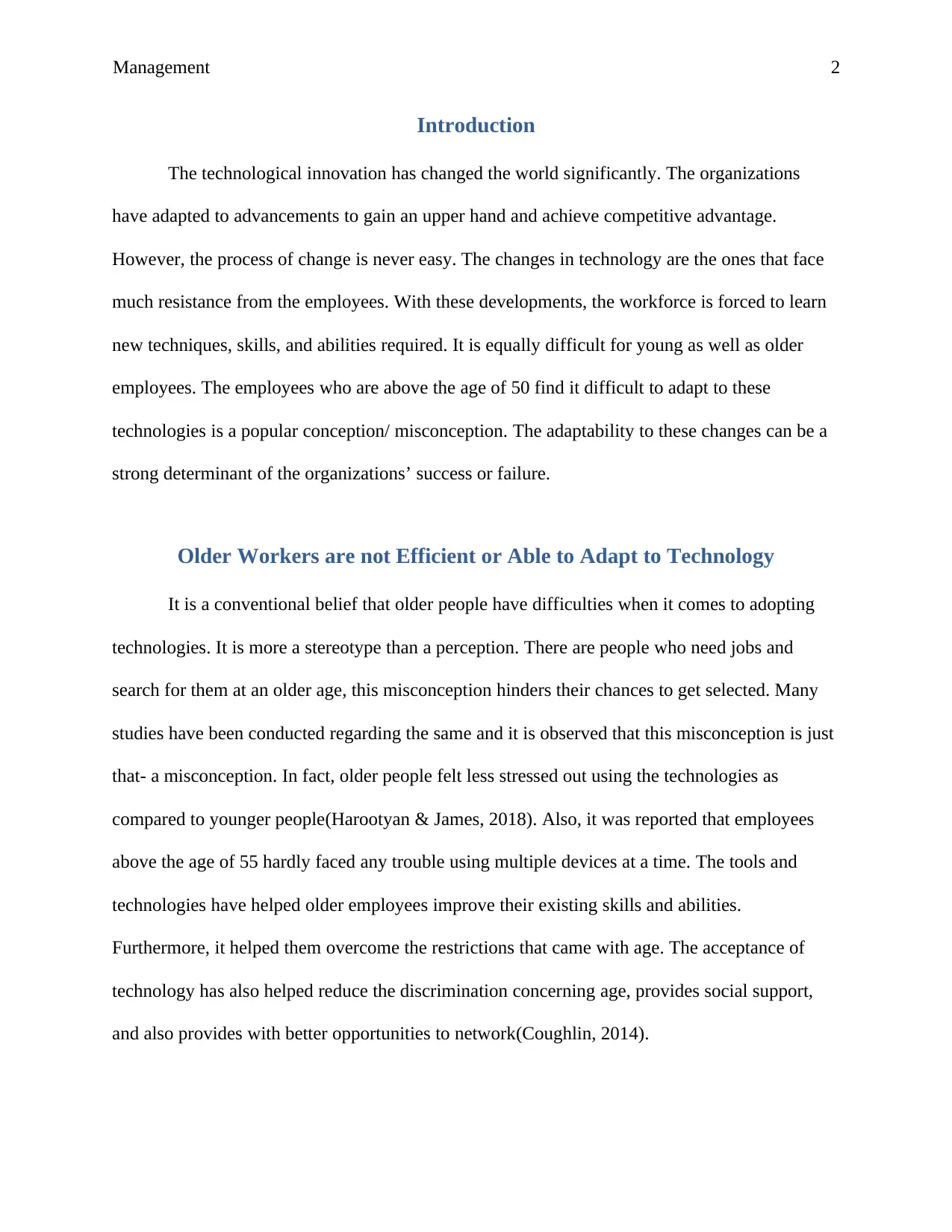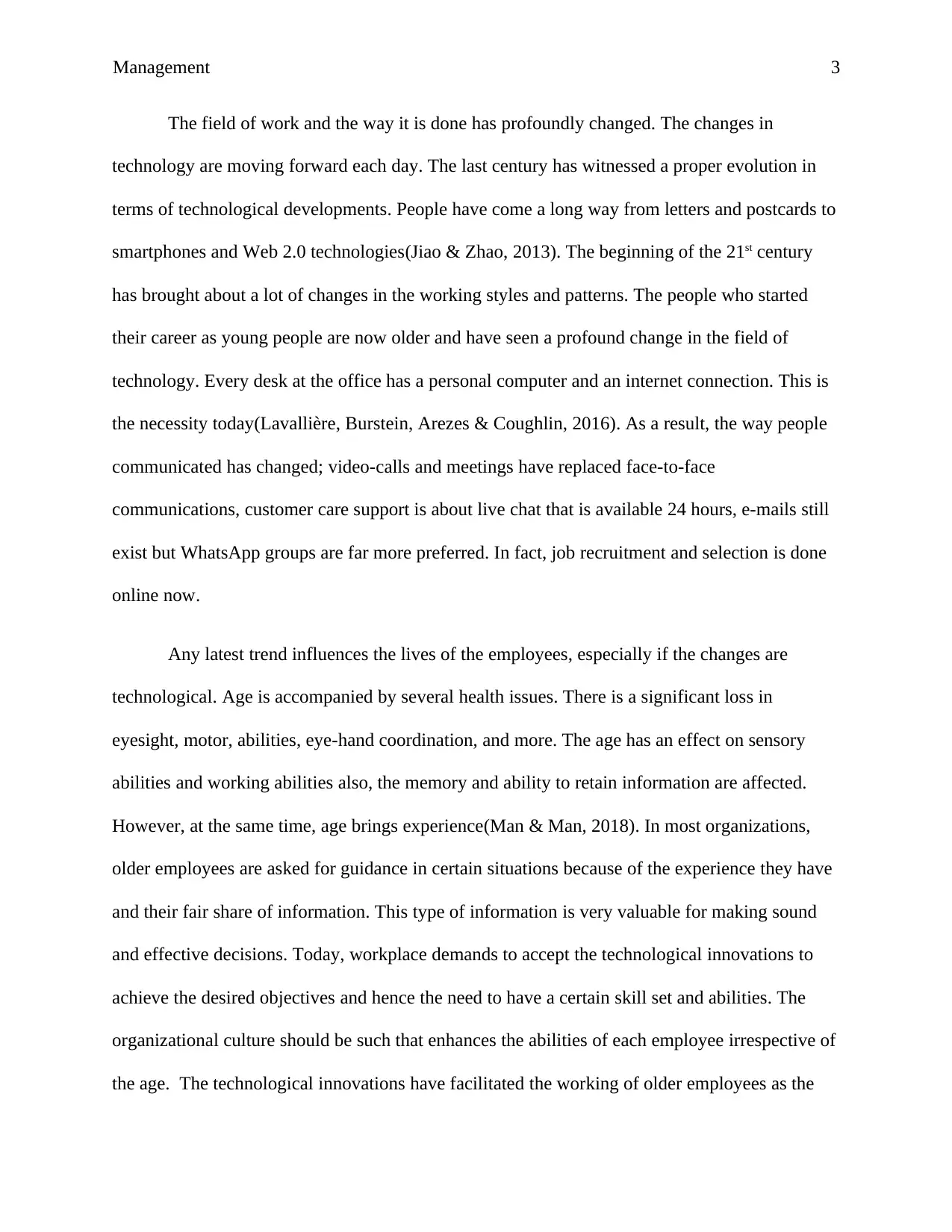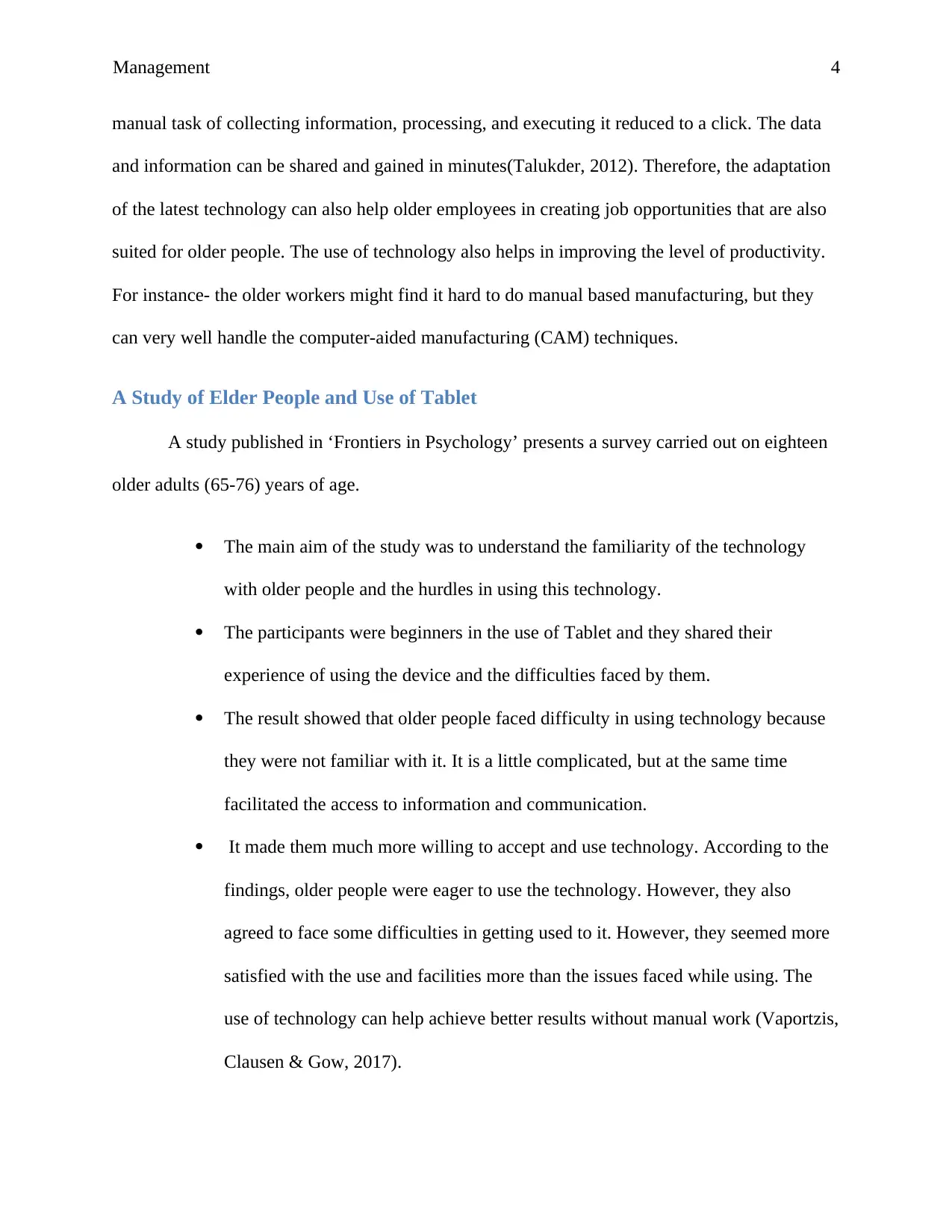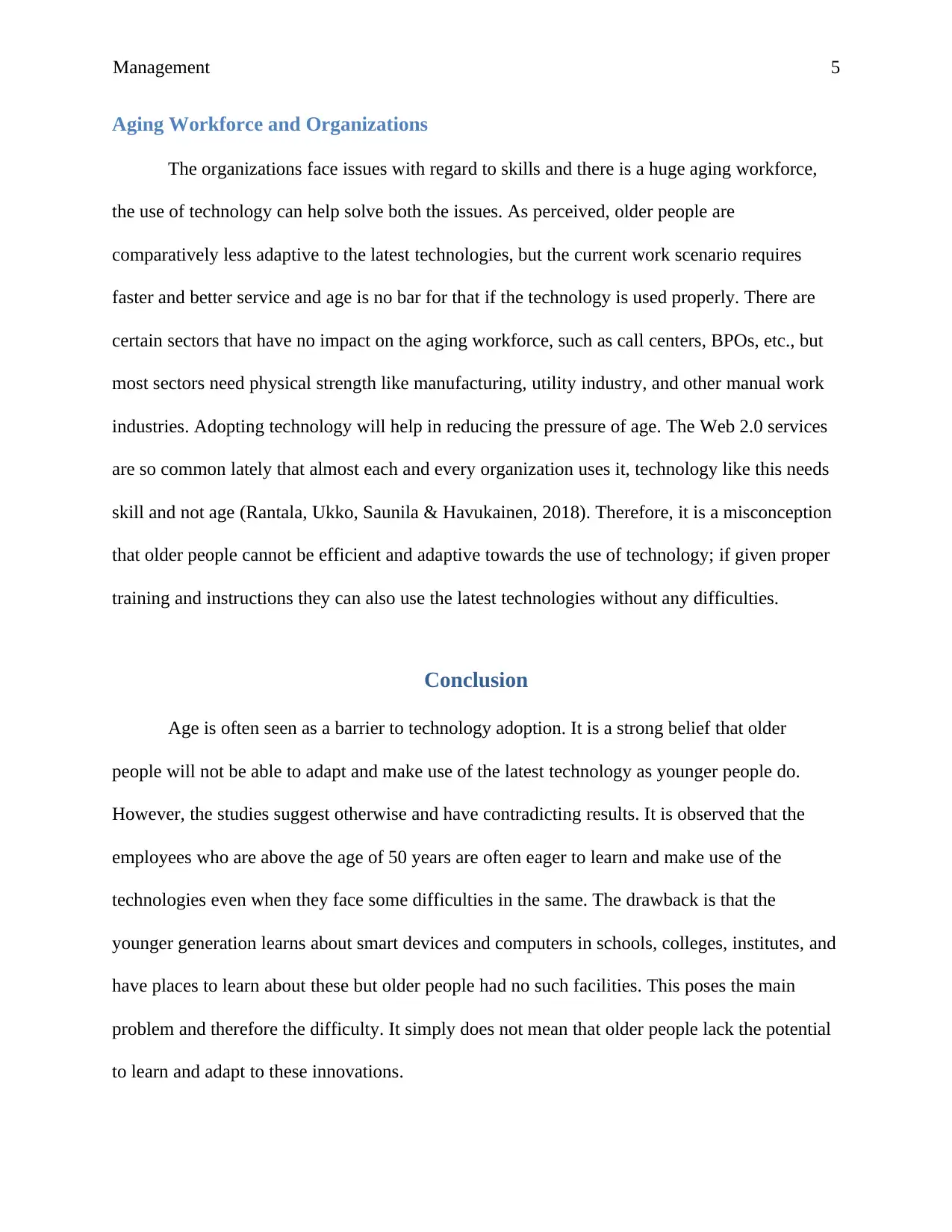Misconception Report: Older Workers, Technology, and Management
VerifiedAdded on 2022/12/29
|8
|1715
|78
Report
AI Summary
This report, prepared for an Introduction to Management course, critically examines the common misconception that older workers are inefficient and unable to adapt to new technologies. It begins with an introduction highlighting the impact of technological innovation on organizations and the resistance to change often encountered. The report then delves into the stereotype that older employees struggle with technology, arguing that this is more a misconception than reality, supported by research indicating that older adults often experience less stress and can effectively utilize multiple devices. The report references studies and data to challenge this belief and emphasizes the valuable experience older workers bring to the workplace. It includes a study on older adults' tablet usage, which highlights their eagerness to learn and adapt, despite initial challenges. The report concludes by emphasizing that age should not be seen as a barrier to technology adoption, and that with proper training and organizational support, older workers can be just as effective as their younger counterparts. The report integrates research, discusses the changing work environment, the importance of organizational culture, and the benefits of technology for older employees, and offers an analysis of the topic, offering valuable insights for management students.

Management 0
Title: Introduction of Management
Assignment Name:
Student Name:
Course Name and Number:
Professor:
Date:
Table of Contents
Title: Introduction of Management
Assignment Name:
Student Name:
Course Name and Number:
Professor:
Date:
Table of Contents
Paraphrase This Document
Need a fresh take? Get an instant paraphrase of this document with our AI Paraphraser

Management 1
Introduction......................................................................................................................................2
Older Workers are not Efficient or Able to Adapt to Technology..................................................2
A Study of Elder People and Use of Tablet.................................................................................4
Aging Workforce and Organizations...........................................................................................5
Conclusion.......................................................................................................................................5
References........................................................................................................................................6
Introduction......................................................................................................................................2
Older Workers are not Efficient or Able to Adapt to Technology..................................................2
A Study of Elder People and Use of Tablet.................................................................................4
Aging Workforce and Organizations...........................................................................................5
Conclusion.......................................................................................................................................5
References........................................................................................................................................6

Management 2
Introduction
The technological innovation has changed the world significantly. The organizations
have adapted to advancements to gain an upper hand and achieve competitive advantage.
However, the process of change is never easy. The changes in technology are the ones that face
much resistance from the employees. With these developments, the workforce is forced to learn
new techniques, skills, and abilities required. It is equally difficult for young as well as older
employees. The employees who are above the age of 50 find it difficult to adapt to these
technologies is a popular conception/ misconception. The adaptability to these changes can be a
strong determinant of the organizations’ success or failure.
Older Workers are not Efficient or Able to Adapt to Technology
It is a conventional belief that older people have difficulties when it comes to adopting
technologies. It is more a stereotype than a perception. There are people who need jobs and
search for them at an older age, this misconception hinders their chances to get selected. Many
studies have been conducted regarding the same and it is observed that this misconception is just
that- a misconception. In fact, older people felt less stressed out using the technologies as
compared to younger people(Harootyan & James, 2018). Also, it was reported that employees
above the age of 55 hardly faced any trouble using multiple devices at a time. The tools and
technologies have helped older employees improve their existing skills and abilities.
Furthermore, it helped them overcome the restrictions that came with age. The acceptance of
technology has also helped reduce the discrimination concerning age, provides social support,
and also provides with better opportunities to network(Coughlin, 2014).
Introduction
The technological innovation has changed the world significantly. The organizations
have adapted to advancements to gain an upper hand and achieve competitive advantage.
However, the process of change is never easy. The changes in technology are the ones that face
much resistance from the employees. With these developments, the workforce is forced to learn
new techniques, skills, and abilities required. It is equally difficult for young as well as older
employees. The employees who are above the age of 50 find it difficult to adapt to these
technologies is a popular conception/ misconception. The adaptability to these changes can be a
strong determinant of the organizations’ success or failure.
Older Workers are not Efficient or Able to Adapt to Technology
It is a conventional belief that older people have difficulties when it comes to adopting
technologies. It is more a stereotype than a perception. There are people who need jobs and
search for them at an older age, this misconception hinders their chances to get selected. Many
studies have been conducted regarding the same and it is observed that this misconception is just
that- a misconception. In fact, older people felt less stressed out using the technologies as
compared to younger people(Harootyan & James, 2018). Also, it was reported that employees
above the age of 55 hardly faced any trouble using multiple devices at a time. The tools and
technologies have helped older employees improve their existing skills and abilities.
Furthermore, it helped them overcome the restrictions that came with age. The acceptance of
technology has also helped reduce the discrimination concerning age, provides social support,
and also provides with better opportunities to network(Coughlin, 2014).
⊘ This is a preview!⊘
Do you want full access?
Subscribe today to unlock all pages.

Trusted by 1+ million students worldwide

Management 3
The field of work and the way it is done has profoundly changed. The changes in
technology are moving forward each day. The last century has witnessed a proper evolution in
terms of technological developments. People have come a long way from letters and postcards to
smartphones and Web 2.0 technologies(Jiao & Zhao, 2013). The beginning of the 21st century
has brought about a lot of changes in the working styles and patterns. The people who started
their career as young people are now older and have seen a profound change in the field of
technology. Every desk at the office has a personal computer and an internet connection. This is
the necessity today(Lavallière, Burstein, Arezes & Coughlin, 2016). As a result, the way people
communicated has changed; video-calls and meetings have replaced face-to-face
communications, customer care support is about live chat that is available 24 hours, e-mails still
exist but WhatsApp groups are far more preferred. In fact, job recruitment and selection is done
online now.
Any latest trend influences the lives of the employees, especially if the changes are
technological. Age is accompanied by several health issues. There is a significant loss in
eyesight, motor, abilities, eye-hand coordination, and more. The age has an effect on sensory
abilities and working abilities also, the memory and ability to retain information are affected.
However, at the same time, age brings experience(Man & Man, 2018). In most organizations,
older employees are asked for guidance in certain situations because of the experience they have
and their fair share of information. This type of information is very valuable for making sound
and effective decisions. Today, workplace demands to accept the technological innovations to
achieve the desired objectives and hence the need to have a certain skill set and abilities. The
organizational culture should be such that enhances the abilities of each employee irrespective of
the age. The technological innovations have facilitated the working of older employees as the
The field of work and the way it is done has profoundly changed. The changes in
technology are moving forward each day. The last century has witnessed a proper evolution in
terms of technological developments. People have come a long way from letters and postcards to
smartphones and Web 2.0 technologies(Jiao & Zhao, 2013). The beginning of the 21st century
has brought about a lot of changes in the working styles and patterns. The people who started
their career as young people are now older and have seen a profound change in the field of
technology. Every desk at the office has a personal computer and an internet connection. This is
the necessity today(Lavallière, Burstein, Arezes & Coughlin, 2016). As a result, the way people
communicated has changed; video-calls and meetings have replaced face-to-face
communications, customer care support is about live chat that is available 24 hours, e-mails still
exist but WhatsApp groups are far more preferred. In fact, job recruitment and selection is done
online now.
Any latest trend influences the lives of the employees, especially if the changes are
technological. Age is accompanied by several health issues. There is a significant loss in
eyesight, motor, abilities, eye-hand coordination, and more. The age has an effect on sensory
abilities and working abilities also, the memory and ability to retain information are affected.
However, at the same time, age brings experience(Man & Man, 2018). In most organizations,
older employees are asked for guidance in certain situations because of the experience they have
and their fair share of information. This type of information is very valuable for making sound
and effective decisions. Today, workplace demands to accept the technological innovations to
achieve the desired objectives and hence the need to have a certain skill set and abilities. The
organizational culture should be such that enhances the abilities of each employee irrespective of
the age. The technological innovations have facilitated the working of older employees as the
Paraphrase This Document
Need a fresh take? Get an instant paraphrase of this document with our AI Paraphraser

Management 4
manual task of collecting information, processing, and executing it reduced to a click. The data
and information can be shared and gained in minutes(Talukder, 2012). Therefore, the adaptation
of the latest technology can also help older employees in creating job opportunities that are also
suited for older people. The use of technology also helps in improving the level of productivity.
For instance- the older workers might find it hard to do manual based manufacturing, but they
can very well handle the computer-aided manufacturing (CAM) techniques.
A Study of Elder People and Use of Tablet
A study published in ‘Frontiers in Psychology’ presents a survey carried out on eighteen
older adults (65-76) years of age.
The main aim of the study was to understand the familiarity of the technology
with older people and the hurdles in using this technology.
The participants were beginners in the use of Tablet and they shared their
experience of using the device and the difficulties faced by them.
The result showed that older people faced difficulty in using technology because
they were not familiar with it. It is a little complicated, but at the same time
facilitated the access to information and communication.
It made them much more willing to accept and use technology. According to the
findings, older people were eager to use the technology. However, they also
agreed to face some difficulties in getting used to it. However, they seemed more
satisfied with the use and facilities more than the issues faced while using. The
use of technology can help achieve better results without manual work (Vaportzis,
Clausen & Gow, 2017).
manual task of collecting information, processing, and executing it reduced to a click. The data
and information can be shared and gained in minutes(Talukder, 2012). Therefore, the adaptation
of the latest technology can also help older employees in creating job opportunities that are also
suited for older people. The use of technology also helps in improving the level of productivity.
For instance- the older workers might find it hard to do manual based manufacturing, but they
can very well handle the computer-aided manufacturing (CAM) techniques.
A Study of Elder People and Use of Tablet
A study published in ‘Frontiers in Psychology’ presents a survey carried out on eighteen
older adults (65-76) years of age.
The main aim of the study was to understand the familiarity of the technology
with older people and the hurdles in using this technology.
The participants were beginners in the use of Tablet and they shared their
experience of using the device and the difficulties faced by them.
The result showed that older people faced difficulty in using technology because
they were not familiar with it. It is a little complicated, but at the same time
facilitated the access to information and communication.
It made them much more willing to accept and use technology. According to the
findings, older people were eager to use the technology. However, they also
agreed to face some difficulties in getting used to it. However, they seemed more
satisfied with the use and facilities more than the issues faced while using. The
use of technology can help achieve better results without manual work (Vaportzis,
Clausen & Gow, 2017).

Management 5
Aging Workforce and Organizations
The organizations face issues with regard to skills and there is a huge aging workforce,
the use of technology can help solve both the issues. As perceived, older people are
comparatively less adaptive to the latest technologies, but the current work scenario requires
faster and better service and age is no bar for that if the technology is used properly. There are
certain sectors that have no impact on the aging workforce, such as call centers, BPOs, etc., but
most sectors need physical strength like manufacturing, utility industry, and other manual work
industries. Adopting technology will help in reducing the pressure of age. The Web 2.0 services
are so common lately that almost each and every organization uses it, technology like this needs
skill and not age (Rantala, Ukko, Saunila & Havukainen, 2018). Therefore, it is a misconception
that older people cannot be efficient and adaptive towards the use of technology; if given proper
training and instructions they can also use the latest technologies without any difficulties.
Conclusion
Age is often seen as a barrier to technology adoption. It is a strong belief that older
people will not be able to adapt and make use of the latest technology as younger people do.
However, the studies suggest otherwise and have contradicting results. It is observed that the
employees who are above the age of 50 years are often eager to learn and make use of the
technologies even when they face some difficulties in the same. The drawback is that the
younger generation learns about smart devices and computers in schools, colleges, institutes, and
have places to learn about these but older people had no such facilities. This poses the main
problem and therefore the difficulty. It simply does not mean that older people lack the potential
to learn and adapt to these innovations.
Aging Workforce and Organizations
The organizations face issues with regard to skills and there is a huge aging workforce,
the use of technology can help solve both the issues. As perceived, older people are
comparatively less adaptive to the latest technologies, but the current work scenario requires
faster and better service and age is no bar for that if the technology is used properly. There are
certain sectors that have no impact on the aging workforce, such as call centers, BPOs, etc., but
most sectors need physical strength like manufacturing, utility industry, and other manual work
industries. Adopting technology will help in reducing the pressure of age. The Web 2.0 services
are so common lately that almost each and every organization uses it, technology like this needs
skill and not age (Rantala, Ukko, Saunila & Havukainen, 2018). Therefore, it is a misconception
that older people cannot be efficient and adaptive towards the use of technology; if given proper
training and instructions they can also use the latest technologies without any difficulties.
Conclusion
Age is often seen as a barrier to technology adoption. It is a strong belief that older
people will not be able to adapt and make use of the latest technology as younger people do.
However, the studies suggest otherwise and have contradicting results. It is observed that the
employees who are above the age of 50 years are often eager to learn and make use of the
technologies even when they face some difficulties in the same. The drawback is that the
younger generation learns about smart devices and computers in schools, colleges, institutes, and
have places to learn about these but older people had no such facilities. This poses the main
problem and therefore the difficulty. It simply does not mean that older people lack the potential
to learn and adapt to these innovations.
⊘ This is a preview!⊘
Do you want full access?
Subscribe today to unlock all pages.

Trusted by 1+ million students worldwide

Management 6
References
Coughlin, J. (2014). Technology, Innovation, and Developing a NexGen Aging Services
Workforce. Public Policy & Aging Report, 24(1), 6-9.
Harootyan, B., & James, J. (2018). Presidential Symposium: Dynamics And Diversity Of The
Aging Workforce—Health, Training, Technology, Employers, And Policy. Innovation In
Aging, 2(suppl_1), 442-442.
Jiao, H., & Zhao, G. (2013). When Will Employees Embrace Managers' Technological
Innovations? The Mediating Effects of Employees' Perceptions of Fairness on Their
Willingness to Accept Change and its Legitimacy. Journal Of Product Innovation
Management, 31(4), 780-798.
Lavallière, M., Burstein, A., Arezes, P., & Coughlin, J. (2016). Tackling the challenges of an aging
workforce with the use of wearable technologies and the quantified-self. DYNA, 83(197),
38.
Man, G., & Man, M. (2018). Competence of Older Employees. Scientific Bulletin, 23(2), 89-93.
Rantala, T., Ukko, J., Saunila, M., & Havukainen, J. (2018). The effect of sustainability in the
adoption of technological, service, and business model innovations. Journal Of Cleaner
Production, 172, 46-55.
Talukder, M. (2012). Factors affecting the adoption of technological innovation by individual
employees: An Australian study. Procedia - Social And Behavioral Sciences, 40, 52-57.
References
Coughlin, J. (2014). Technology, Innovation, and Developing a NexGen Aging Services
Workforce. Public Policy & Aging Report, 24(1), 6-9.
Harootyan, B., & James, J. (2018). Presidential Symposium: Dynamics And Diversity Of The
Aging Workforce—Health, Training, Technology, Employers, And Policy. Innovation In
Aging, 2(suppl_1), 442-442.
Jiao, H., & Zhao, G. (2013). When Will Employees Embrace Managers' Technological
Innovations? The Mediating Effects of Employees' Perceptions of Fairness on Their
Willingness to Accept Change and its Legitimacy. Journal Of Product Innovation
Management, 31(4), 780-798.
Lavallière, M., Burstein, A., Arezes, P., & Coughlin, J. (2016). Tackling the challenges of an aging
workforce with the use of wearable technologies and the quantified-self. DYNA, 83(197),
38.
Man, G., & Man, M. (2018). Competence of Older Employees. Scientific Bulletin, 23(2), 89-93.
Rantala, T., Ukko, J., Saunila, M., & Havukainen, J. (2018). The effect of sustainability in the
adoption of technological, service, and business model innovations. Journal Of Cleaner
Production, 172, 46-55.
Talukder, M. (2012). Factors affecting the adoption of technological innovation by individual
employees: An Australian study. Procedia - Social And Behavioral Sciences, 40, 52-57.
Paraphrase This Document
Need a fresh take? Get an instant paraphrase of this document with our AI Paraphraser

Management 7
Vaportzis, E., Clausen, M., & Gow, A. (2017). Older adults perception of technology and barriers
to interacting with tablet computers: a focus group study. Retrieved from
https://www.ncbi.nlm.nih.gov/pmc/articles/PMC5649151/
Vaportzis, E., Clausen, M., & Gow, A. (2017). Older adults perception of technology and barriers
to interacting with tablet computers: a focus group study. Retrieved from
https://www.ncbi.nlm.nih.gov/pmc/articles/PMC5649151/
1 out of 8
Related Documents
Your All-in-One AI-Powered Toolkit for Academic Success.
+13062052269
info@desklib.com
Available 24*7 on WhatsApp / Email
![[object Object]](/_next/static/media/star-bottom.7253800d.svg)
Unlock your academic potential
Copyright © 2020–2025 A2Z Services. All Rights Reserved. Developed and managed by ZUCOL.




